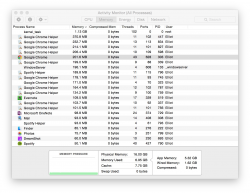Hey, I got a new MacBook Pro 13" 2015 with 16GB RAM a couple of weeks ago and updated to 10.10.3 yesterday.
I've been on the computer a couple hours after restarting it, and this is what my memory tab on activity monitor:
I'm fairly sure that before the update, the memory used was generally around 16GB or a bit under, but it seems to not be getting over 8GB now - is this a problem? I'm concerned the computer is not using all of the RAM available to it. I'm not sure if the computer is more sluggish since the update or not; I suspect it might be getting more stuttery on complex websites with video etc. but I can't really objectively tell.
Thanks
I've been on the computer a couple hours after restarting it, and this is what my memory tab on activity monitor:
I'm fairly sure that before the update, the memory used was generally around 16GB or a bit under, but it seems to not be getting over 8GB now - is this a problem? I'm concerned the computer is not using all of the RAM available to it. I'm not sure if the computer is more sluggish since the update or not; I suspect it might be getting more stuttery on complex websites with video etc. but I can't really objectively tell.
Thanks



